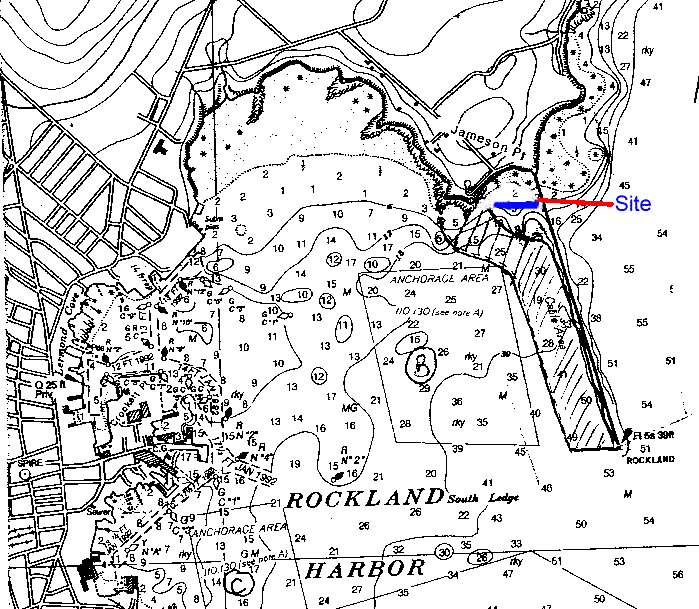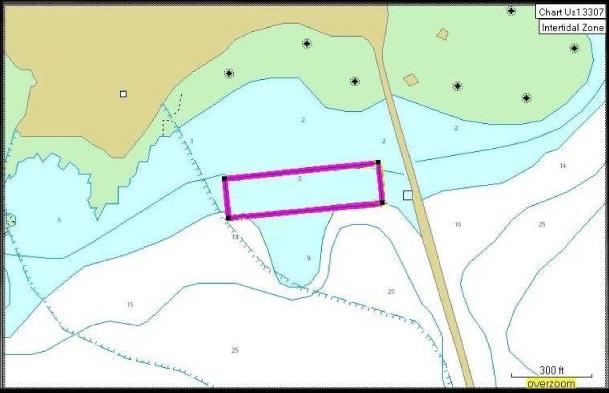
APPLICATION FOR EXPERIMENTAL AQUACULTURE LEASE
Neal Parker. Location: Rockland Harbor, Rockland Maine.
1. Location of Proposed Lease.

B. Boundary Description. The lease site is bounded as follows:
Starting at the NE corner (nearshore and near the breakwater) and working clockwise. (See Map 3)
NE - 44o 06.837' N by 69o 04.908' W then 85 feet at 166.24 degrees true to
SE - 44o 06.823' N by 69o 04.903' W then 1081.8 feet at 264.5 degrees true to
SW - 44o 06.806' N by 69o 05.149' W then 141.7 feet at 47.8 degrees true to
NW - 44o 06.822' N by 69o 05.125' W then 955.9 feet at 84.5 degrees true back to NE corner
Total acreage: 1.98 acres.

2. Riparian Land Owners within 1,000 feet. Please refer to enclosed Tax Map.
1. US Army Corps of Engineers. Maine Project Office.
675 Western Avenue #3, Manchester, Maine 04351 (207) 623-8367
2. Samorock LLC, 220 Warrenton Street, Rockport ME 04856. (207) 594-2511
3. Jameson Point Association. 100 Jameson Point Road, Rockland, ME 04841
4. City of Rockland, 270 Pleasant Street Rockland, ME 04841
5. Madeline Philbrick, 85 Samoset Road, Rockland Maine 04841
Access to the site will be from Mary Read Town Park adjacent to the site, from the Rockland Breakwater and by skiff from the Rockland town landing as needed. A private dock may also be used if it becomes available.
3. Research Program and Operation
A. The purpose and design of the study. Determine whether commercially significant quantities of coralline algae, sponges and eelgrass seed can be grown in a protected shallow subtidal location in Rockland Harbor, Penobscot Bay.
B. The species, amount and source of the organisms to be grown.
Page 2
(2) Clathromorphum circumscriptum, an unbranched, coralline red algae common to Maine waters. This algae covers rock and shell surfaces with a hard film, frequently forming a secondary habitat substrate for kelp species. 500 "live rocks" with the species growing on it will be collected from areas within the lease site and from nearby locations in West Penobscot Bay.
The site will first be extensively videotaped using a towed videocamera. Any manmade marine debris on the site will be removed.
Eelgrass seed.
Eelgrass (Zostera marina) Eelgrass seed will be non-lethally obtained via wader or kayaker removing seed pods from living plants within west Penobscot Bay eelgrass stands. The seed will be sorted, processed and hand sown during slack tides at a variety of densities, from ten seeds per square meter to 100 seeds per square meter in plots within the lease site. Eelgrass seeding efforts elsewhere in New England indicate germination and age zero survival rates of hand sown seed vary from 10% to 50%. Sowing and post harvest processing will follow guidelines laid out in the eelgrass restoration project handbook published by Save The Bay conservation group of Rhode Island, which has worked with Bagaduce Watershed Coalition on eelgrass restoration there.Germination success and growth will be monitored by wading and by kayak, using a glass bottomed viewer. At seed harvest time the ripe seed pods will be manually cut from the eelgrass plants, and brought ashore for sorting and processing. Processing involves suspending mesh bags of eelgrass seedpods in the bay from a private dock until the pods disintegrate, leaving the seeds in the net bags. Each year of the lease, seed pods will be collected and the amount of seeds produced per plot measured.
Coralline Algae & Sponges.
Page 3
The items will be attached to the live rocks & sponges using several methods commonly used by the marine aquarium industry: adhesives and banding.
Adhesives: Research in the marine science and saltwater aquarium industry indicates that epoxy and "super glue" are safe, easy to use adhesives for cementing items to coralline live rock and sponges.
Banding: Some of the items and live rocks and sponges will be held together with lobster claw rubber bands or other small elastics.
Representative live rocks & sponges will be periodically retrieved and evaluated as to the degree of coral encrustation of the live rocks and sponges and the items affixed to them at various depths and substrate locations. Those that have achieved desired qualities will be harvested, measured and processed. Others will be returned to the site for further growth.
2. Lithothamnion lemoineae Up to 500 "live rocks" with this species growing on it will be collected from areas within the lease site and nearby locations. An assortment of items will be affixed to half of them. The live rocks will be distributed in clusters at different locations and depths in the lease site area.
The items will be attached to the live rocks using several methods commonly used by the marine aquarium industry: adhesives and banding as described above. After one year, half of the live rocks of both species will be retrieved and evaluated as to the degree and quality of successful coralline encrustation of the rocks and of the items affixed to half of them. Those that have achieved successful encrustation will be brought to shore and processed. The others will be returned to their clusters.
The sponge species will be similarly evaluated. Some will have pieces of shell or other native natural materials affixed to them to attempt to influence the shape of the sponges during growth.
These evaluation processes will continue throughout the three year lease.
D. The expected length of the study.
The expected length of the study is three years.
E. Specify whether the research is for scientific OR commercial research and development. Research is for commercial research to determine what quantity of eelgrass seed, sponges and coralline algae can be produced at this location.
Page 4
4. __Existing Uses. Site is used for recreational and commercial uses, including wading, boating, storm anchorage, lobstering and shellfishing. There is a seasonal float in the lease site. There is a submerged cable area to the west and south of the site.
Signed statement from either the local harbor master, DMR Area Biologist, Marine Patrol Officer or the Aquaculture Environmental Coordinator that describes fishing activity, moorings, navigational channels in the area and use of the area by local landowners for access to and from their property. See attached statement from Rockland Harbormaster.
9. __Exclusive Use (Who will be restricted from the site?)
All existing recreational and navigational uses will be permitted throughout the lease area. Lobstering, crabbing, urchin diving and hook fishing will be permitted throughout the lease site. Mobile bottom gear fisheries will be restricted from the site following seeding and placement of the eelgrass, coralline rocks and sponges. No new or expanded permanent or seasonal private piers, floats, moorings, boat launching facilities or other structures will be permitted within the lease area without permission of the leaseholder.
6. __Description of the Proposed Lease Site
A. Environmental Characterization.
Describe the environment of the proposed lease site and your reasons for deciding that this site would work for your intended purposes.
1. Bottom Characteristics. A combination of muddy, sandy, rocky, and cobble environments that are ideal for experimental seeding with eelgrass seed, coralline rocks and sponges due to their being sheltered and easily accessible.
2. Approximate depths at low and high tides: Rockland harbor has an average 10 to 11 foot tide range. At low tide most of the site is 9 feet deep. About 20% of the lease towards the middle is 5 feet deep at low tide. High tide: most of the site is 19 to 20 feet deep with a portion that is approximately 16 feet deep at high tide.
Page 5
Kelp, coralline algae, sponges and eelgrass are patchy to common in Rockland Harbor, including the proposed lease area. Green crabs, blue mussels, sculpins, Atlantic tomcod are common. Herring, mackerel, bluefish and striped bass may be abundant seasonally. Sea urchins and scallops may occasionally visit the area. Sources: local fishermen and ‘Abundance and distribution of fishes and invertebrates in North Atlantic Estuaries’, published by NOAA ELMR Program May 1994
6. The general shoreline and upland characteristics.
The shoreline adjacent to the lease site is an undeveloped rocky beach. A bluff rises above the beach. Above the beach, a walkway leading from Marie Reed Town Park to the Rockland Breakwater separates the beach from a private golf course. To the west of the site is the Rockland Breakwater.
B. Environmental Impact.
Describe how you think your husbandry and harvesting techniques might affect the physical and ecological environment around the lease site.
Species to be raised in the lease site are all native to the area. The local increase in abundance of these species will have a positive effect on other native species that use these species for habitat and food. The seeding of eelgrass, coralline algae rocks and sponges will be carried out by hand. The harvesting of eelgrass seeds from the lease will be carried out by a wader or kayaker and will not harm the eelgrass plants. The coralline rocks and sponges will be hand deployed & retrieved by wader or diver. There will be no adverse impacts to the ecological environment of the area.
7 . _ Structures (if applicable) No structures
A. Plan View. N/A No structures.
B. Cross section N/A No structures.
8. Discharge
(if applicable)There will be no discharges from the site. No materials other than the eelgrass seeds, sponges and the native coralline live rocks, some with nontoxic items affixed to them, will be added to the lease site.
Page 6
9. __ Escrow Account and Rental Fee
A. Escrow Account or Performance Bond. N/A No discharge.
B. Rental Fee. The rental fee is $100 ($50.00 per acre) for the first year of the lease term.
END OF APPLICATION